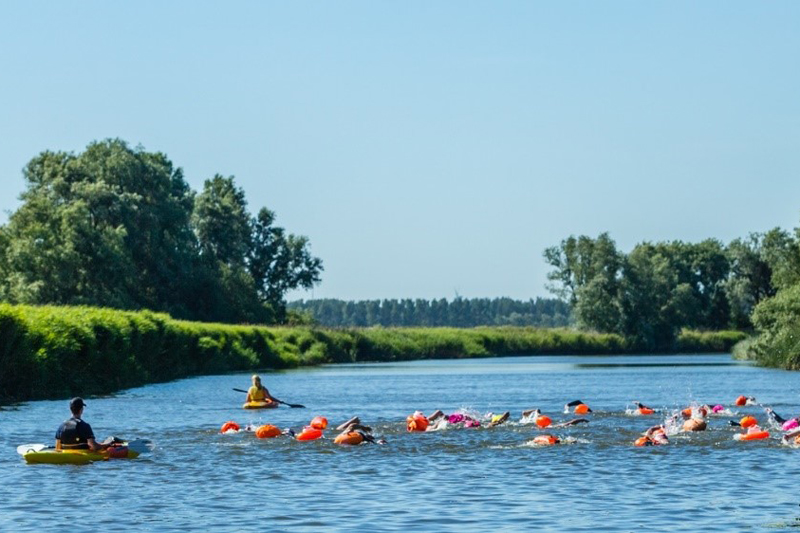Outdoor swimming
When the weather is warm it can be very tempting to go for a swim in the Broads. This is potentially very dangerous without the benefit of support from an open water swimming organisation. The Broads Authority strongly advises against entering the water unless part of an organised event.

Open water swimming is growing in popularity in the UK, and with over 120 miles of waterways, the demand to swim within the waters of the Norfolk and Suffolk Broads is continually increasing.
Risks of swimming in the Broads
While recognising the benefits to health and well-being, a balanced assessment must be undertaken by all participants as swimming in the Broads carries numerous risks:
- Cold water shock - Entering cold water can cause involuntary gasp reflex and cold incapacitation even in summer. Jumping in can cause you to involuntarily breathe in under water or to hyperventilate and panic. Staying in cool water too long can cause your muscles to lose power and make swimming and getting out of the water difficult, both of which can lead to drowning.
- Boats and other river users - The Broads are busy with boats and especially in the summer months. Motor cruisers in particular can be very large and may struggle to see swimmers. If you do swim it makes sense to avoid busy stretches of the rivers.
- Water-borne diseases and blue-green algae - Open water swimming may expose you to water-borne diseases such as Weil's disease (caught by humans through contact with animal urine in contaminated fresh water) and Blue green algae. See below for our advice.
- Hypothermia - can be caused by getting too cold and not warming up fully after swimming.
- Strong tidal currents - Although all of the Broads' rivers are tidal in some areas it is stronger than others. Swimming in highly tidal areas such as the Lower Bure and Lower Yare can cause fatigue and make exiting the water very difficult.
- Water plants - These can be found in the Broads waterways and are an important part of the river system. They are a risk to swimmers as they can cause entanglement. We advise not to swim in areas with a high density of water plants, however if you find yourself caught it is important not to panic and to swim downstream using your arms only.
- Hidden obstructions - The presence of hidden obstructions under the water, such as trees, quay-heading or other objects can cause serious injury and swimmers should take care entering the water and never dive in. Deep mud can cause difficulties and swimmers should avoid shallow water at all times.
If you do swim
- Don't jump in after consuming alcohol - Alcohol and open water are a bad mix. It impairs judgment, coordination and will make cold water shock worse.
- Wear a wet suit to avoid hypothermia - If swimming outdoors, consider wearing a wet suit, always enter the water gradually, know where you can get out, don't stay in too long and remember to try and get warm quickly. More information can be found at the Outdoor Swimming Society website.
- Avoid highly-tidal areas of the Broads - We strongly urge against swimming in areas of the Broads where the tide is especially strong, for example on the lower River Bure and lower River Yare. The water can be fast-moving here and drastically different to the quieter upper reaches or the smaller rivers.
- Wear a bright swimming hat or tow float to increase visibility - The Broads is very busy with boats all year round, but especially through the summer season. If you are swimming in a wetsuit, it may be very hard to spot you from a boat. We highly recommend you wear a bright swimming hat and use a tow float to ensure you are easily spotted at a distance and boat users can make sure they allow you enough room.
- Avoid swallowing water and cover up any open wounds - If you avoid ingesting water and cover any wounds it will reduce the risk of contracting any infections or diseases from the rivers. Try to have a wash after being in the water and clean your hands before eating/drinking.
- Don't swim near sewage overflows or in areas with blue-green algae - You can see where storm overflows discharge untreated sewage into rivers on the Rivers Trust's Sewage Map. Our advice is to avoid entering the water in these locations if there was recently heavy rainfall. When heavy rain occurs, sewers can discharge directly into rivers, increasing the possibility of infection or disease if you enter the water in these areas. It's also sensible to not swim if an area is experiencing blue-green algal blooms (usually in the summer) as they may make you poorly.
- Be aware of busy moorings - Swimmers may be tempted to enter the river using the safety ladders located on Broads Authority moorings. This is a dangerous place to enter the water as vessels will be constantly manoeuvring to either come alongside or move out into the river.
Helpful links
We encourage anyone looking to swim in the Broads to contact an organisation like Tri-Anglia who successfully organise and deliver open water swimming events within the Broads.
If you are thinking about organising your own open water swimming event, then please contact our waterways team.
There is more detailed advice available through the National Water Safety Forum, the River and Lake Swimming Association and the Swimming in Tidal Rivers and Estuaries.
You can sign up for blue-green algae sightings by registering for iRecord and then setting up a notification alert for "Cyanobacteria" in Norfolk/Suffolk.
Organising events
If you are planning an organised swimming event please see our events guidance web page for more information on how to proceed.

